#include <tinyxml.h>

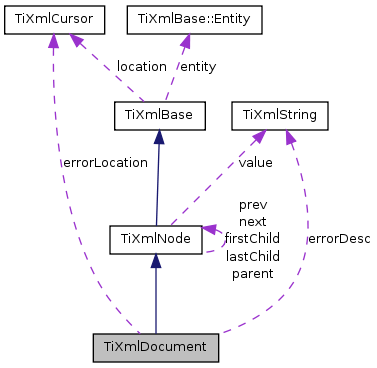
Public Member Functions
- TiXmlDocument ()
- TiXmlDocument (const char *documentName)
- TiXmlDocument (const TiXmlDocument ©)
- void operator= (const TiXmlDocument ©)
- virtual ~TiXmlDocument ()
- bool LoadFile (TiXmlEncoding encoding=TIXML_DEFAULT_ENCODING)
- bool SaveFile () const
- bool LoadFile (const char *filename, TiXmlEncoding encoding=TIXML_DEFAULT_ENCODING)
- bool SaveFile (const char *filename) const
- virtual const char * Parse (const char *p, TiXmlParsingData *data=0, TiXmlEncoding encoding=TIXML_DEFAULT_ENCODING)
- TiXmlElement * RootElement () const
- bool Error () const
- const char * ErrorDesc () const
- const int ErrorId () const
- int ErrorRow ()
- int ErrorCol ()
- The column where the error occured. See ErrorRow().
- The column where the error occured. See ErrorRow().
- void SetTabSize (int _tabsize)
- int TabSize () const
- void ClearError ()
- void Print () const
- virtual void Print (FILE *cfile, int depth=0) const
- void SetError (int err, const char *errorLocation, TiXmlParsingData *prevData, TiXmlEncoding encoding)
Protected Member Functions
- virtual void StreamOut (TiXmlOutStream *out) const
- virtual TiXmlNode * Clone () const
Private Member Functions
- void CopyTo (TiXmlDocument *target) const
Private Attributes
- bool error
- int errorId
- TiXmlString errorDesc
- int tabsize
- TiXmlCursor errorLocation
Detailed Description
Always the top level node. A document binds together all the XML pieces. It can be saved, loaded, and printed to the screen. The 'value' of a document node is the xml file name.
Constructor & Destructor Documentation
| TiXmlDocument::TiXmlDocument | ( | ) |
Create an empty document, that has no name.
References ClearError(), and tabsize.
Referenced by Clone().


| TiXmlDocument::TiXmlDocument | ( | const char * | documentName | ) |
Create a document with a name. The name of the document is also the filename of the xml.
References ClearError(), tabsize, and TiXmlNode::value.

| TiXmlDocument::TiXmlDocument | ( | const TiXmlDocument & | copy | ) |
| virtual TiXmlDocument::~TiXmlDocument | ( | ) | [inline, virtual] |
Member Function Documentation
| void TiXmlDocument::operator= | ( | const TiXmlDocument & | copy | ) |
| bool TiXmlDocument::LoadFile | ( | TiXmlEncoding | encoding = TIXML_DEFAULT_ENCODING |
) |
Load a file using the current document value. Returns true if successful. Will delete any existing document data before loading.
References TiXmlBase::StringToBuffer::buffer, and TiXmlNode::value.
| bool TiXmlDocument::SaveFile | ( | ) | const |
Save a file using the current document value. Returns true if successful.
References TiXmlBase::StringToBuffer::buffer, and TiXmlNode::value.
| bool TiXmlDocument::LoadFile | ( | const char * | filename, | |
| TiXmlEncoding | encoding = TIXML_DEFAULT_ENCODING | |||
| ) |
Load a file using the given filename. Returns true if successful.
References TiXmlString::c_str(), TiXmlCursor::Clear(), TiXmlNode::Clear(), Error(), TiXmlBase::location, Parse(), SetError(), TIXML_ENCODING_UNKNOWN, TiXmlBase::TIXML_ERROR_OPENING_FILE, TIXML_STRING, and TiXmlNode::value.
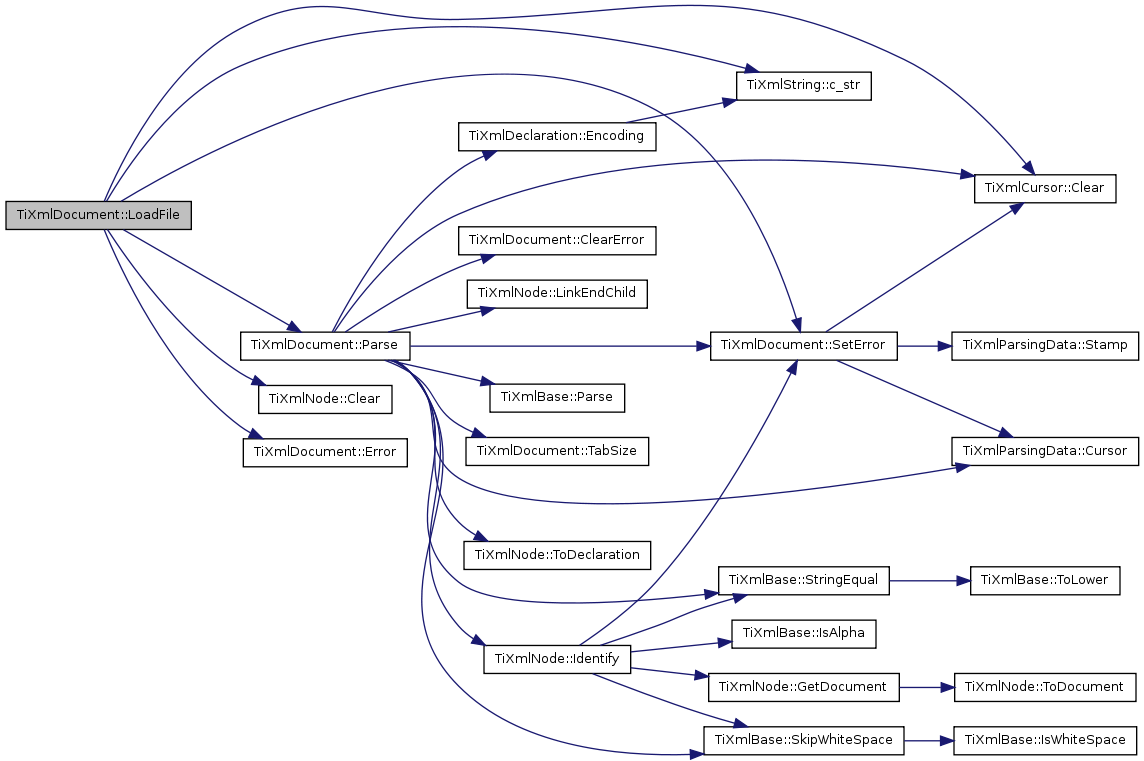
| bool TiXmlDocument::SaveFile | ( | const char * | filename | ) | const |
Save a file using the given filename. Returns true if successful.
References Print().

| const char * TiXmlDocument::Parse | ( | const char * | p, | |
| TiXmlParsingData * | data = 0, |
|||
| TiXmlEncoding | encoding = TIXML_DEFAULT_ENCODING | |||
| ) | [virtual] |
Parse the given null terminated block of xml data. Passing in an encoding to this method (either TIXML_ENCODING_LEGACY or TIXML_ENCODING_UTF8 will force TinyXml to use that encoding, regardless of what TinyXml might otherwise try to detect.
Implements TiXmlBase.
References TiXmlCursor::Clear(), ClearError(), TiXmlCursor::col, TiXmlParsingData::Cursor(), TiXmlParsingData::cursor, TiXmlDeclaration::Encoding(), TiXmlNode::Identify(), TiXmlNode::LinkEndChild(), TiXmlBase::location, TiXmlBase::Parse(), TiXmlCursor::row, SetError(), TiXmlBase::SkipWhiteSpace(), TiXmlBase::StringEqual(), TabSize(), TIXML_ENCODING_UNKNOWN, TiXmlBase::TIXML_ERROR_DOCUMENT_EMPTY, and TiXmlNode::ToDeclaration().
Referenced by CRusCorpXmlFile::CreateGraTable(), LoadFile(), and CConcXml::LoadXmlAndReadBibliography().
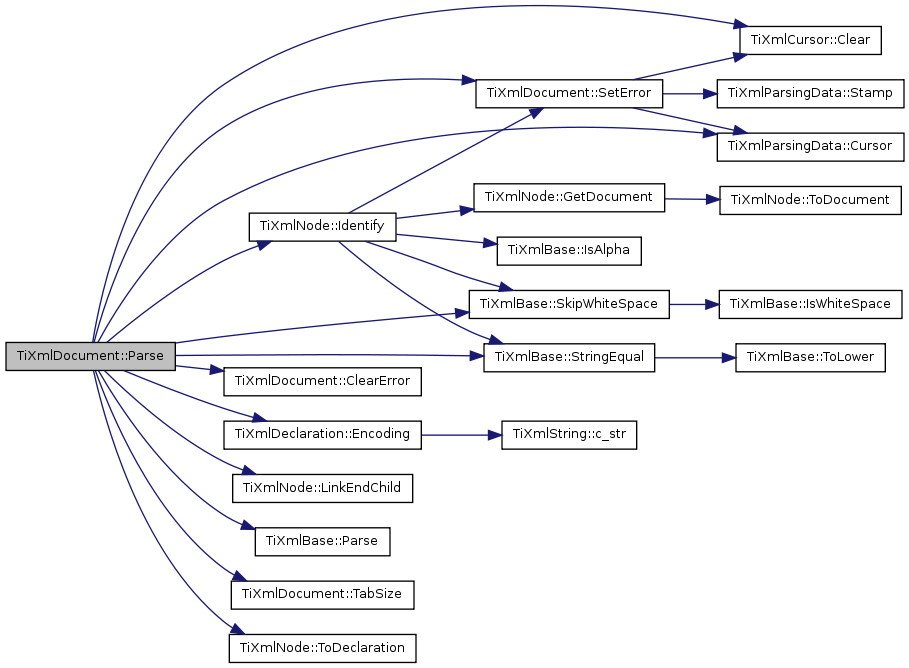

| TiXmlElement* TiXmlDocument::RootElement | ( | ) | const [inline] |
Get the root element -- the only top level element -- of the document. In well formed XML, there should only be one. TinyXml is tolerant of multiple elements at the document level.
References TiXmlNode::FirstChildElement().
Referenced by CConcXml::GetTextAreaElements(), and ReadXmlField().


| bool TiXmlDocument::Error | ( | ) | const [inline] |
If an error occurs, Error will be set to true. Also,
- The ErrorId() will contain the integer identifier of the error (not generally useful)
- The ErrorDesc() method will return the name of the error. (very useful)
- The ErrorRow() and ErrorCol() will return the location of the error (if known)
References error.
Referenced by LoadFile(), and CConcXml::LoadXmlAndReadBibliography().

| const char* TiXmlDocument::ErrorDesc | ( | ) | const [inline] |
Contains a textual (english) description of the error if one occurs.
References TiXmlString::c_str(), and errorDesc.
Referenced by CRusCorpXmlFile::CreateGraTable(), and CConcXml::LoadXmlAndReadBibliography().


| const int TiXmlDocument::ErrorId | ( | ) | const [inline] |
Generally, you probably want the error string ( ErrorDesc() ). But if you prefer the ErrorId, this function will fetch it.
References errorId.
| int TiXmlDocument::ErrorRow | ( | ) | [inline] |
Returns the location (if known) of the error. The first column is column 1, and the first row is row 1. A value of 0 means the row and column wasn't applicable (memory errors, for example, have no row/column) or the parser lost the error. (An error in the error reporting, in that case.)
- See also:
- SetTabSize, Row, Column
References errorLocation, and TiXmlCursor::row.
Referenced by CConcXml::LoadXmlAndReadBibliography().

| int TiXmlDocument::ErrorCol | ( | ) | [inline] |
The column where the error occured. See ErrorRow().
References TiXmlCursor::col, and errorLocation.
Referenced by CConcXml::LoadXmlAndReadBibliography().

| void TiXmlDocument::SetTabSize | ( | int | _tabsize | ) | [inline] |
By calling this method, with a tab size greater than 0, the row and column of each node and attribute is stored when the file is loaded. Very useful for tracking the DOM back in to the source file.
The tab size is required for calculating the location of nodes. If not set, the default of 4 is used. The tabsize is set per document. Setting the tabsize to 0 disables row/column tracking.
Note that row and column tracking is not supported when using operator>>.
The tab size needs to be enabled before the parse or load. Correct usage:
TiXmlDocument doc; doc.SetTabSize( 8 ); doc.Load( "myfile.xml" );
References tabsize.
| int TiXmlDocument::TabSize | ( | ) | const [inline] |
References tabsize.
Referenced by TiXmlAttribute::Parse(), and Parse().

| void TiXmlDocument::ClearError | ( | ) | [inline] |
If you have handled the error, it can be reset with this call. The error state is automatically cleared if you Parse a new XML block.
References TiXmlCursor::col, error, errorDesc, errorId, errorLocation, and TiXmlCursor::row.
Referenced by Parse(), and TiXmlDocument().

| void TiXmlDocument::Print | ( | ) | const [inline] |
Dump the document to standard out.
References Print().
Referenced by Print(), CRusCorpXmlFile::PrintDisambiguatedXmlNodes(), and SaveFile().


| void TiXmlDocument::Print | ( | FILE * | cfile, | |
| int | depth = 0 | |||
| ) | const [virtual] |
Print this Document to a FILE stream.
Implements TiXmlBase.
References TiXmlNode::FirstChild(), TiXmlNode::NextSibling(), and TiXmlBase::Print().

| void TiXmlDocument::SetError | ( | int | err, | |
| const char * | errorLocation, | |||
| TiXmlParsingData * | prevData, | |||
| TiXmlEncoding | encoding | |||
| ) |
References TiXmlCursor::Clear(), TiXmlParsingData::Cursor(), error, errorDesc, errorId, errorLocation, TiXmlBase::errorString, TiXmlParsingData::Stamp(), and TiXmlBase::TIXML_ERROR_STRING_COUNT.
Referenced by TiXmlNode::Identify(), LoadFile(), TiXmlDeclaration::Parse(), TiXmlAttribute::Parse(), TiXmlComment::Parse(), TiXmlUnknown::Parse(), TiXmlElement::Parse(), Parse(), TiXmlElement::ReadValue(), and TiXmlElement::SetAttribute().
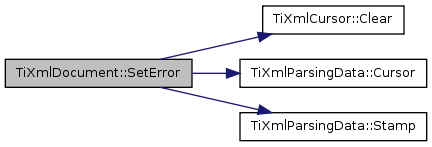

| void TiXmlDocument::StreamOut | ( | TiXmlOutStream * | out | ) | const [protected, virtual] |
Implements TiXmlBase.
References TiXmlNode::FirstChild(), TiXmlNode::NextSibling(), TiXmlBase::StreamOut(), and TiXmlNode::ToElement().
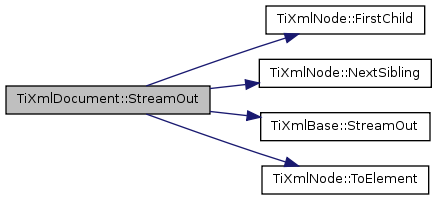
| TiXmlNode * TiXmlDocument::Clone | ( | ) | const [protected, virtual] |
Create an exact duplicate of this node and return it. The memory must be deleted by the caller.
Implements TiXmlNode.
References CopyTo(), and TiXmlDocument().

| void TiXmlDocument::CopyTo | ( | TiXmlDocument * | target | ) | const [private] |
References TiXmlString::c_str(), TiXmlNode::Clone(), error, errorDesc, TiXmlNode::firstChild, TiXmlNode::LinkEndChild(), and TiXmlNode::NextSibling().
Referenced by Clone(), operator=(), and TiXmlDocument().
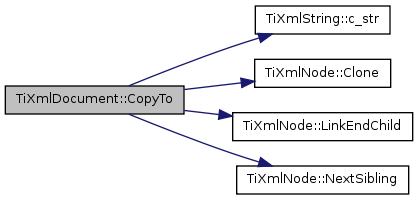

Member Data Documentation
bool TiXmlDocument::error [private] |
Referenced by ClearError(), CopyTo(), Error(), and SetError().
int TiXmlDocument::errorId [private] |
Referenced by ClearError(), ErrorId(), and SetError().
TiXmlString TiXmlDocument::errorDesc [private] |
Referenced by ClearError(), CopyTo(), ErrorDesc(), and SetError().
int TiXmlDocument::tabsize [private] |
Referenced by TiXmlAttribute::Parse(), SetTabSize(), TabSize(), and TiXmlDocument().
TiXmlCursor TiXmlDocument::errorLocation [private] |
Referenced by ClearError(), ErrorCol(), ErrorRow(), and SetError().
The documentation for this class was generated from the following files:


 1.7.1
1.7.1